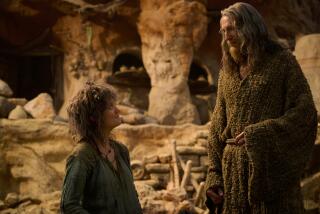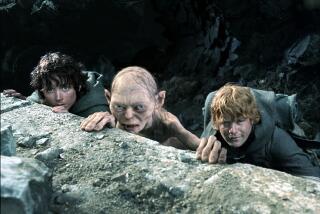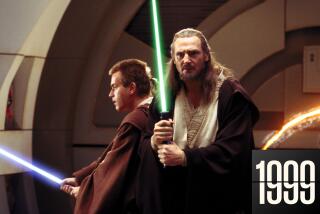Overload of the ‘Rings’?
Crammed into a children’s bookshop in Beverly Hills, Samuel Ellison could barely contain his glee as the cast from the upcoming movie “The Lord of the Rings” regaled the crowd with tales of noble knights and maidens fair.
Ellison, a 36-year-old computer programmer whose mother read him J.R.R. Tolkien’s fantasy stories when he was a child, was enthralled as actor Sean Astin strapped on a bronze sword over the waist of his worn jeans and draped a hobbit cape over his Gap V-neck sweater.
From the fringes of the packed room, someone tossed Astin a hobbit action figure from Burger King.
“I was talking to a friend of mine the other day,” said Astin, who plays the diminutive hobbit Samwise Gamgee in the movie. “He said, ‘You’ll never guess who was on my fries.’ I was like, ‘Really? I was on the fries? Cool!’ ”
Ellison, who was spellbound a second ago, looked as if he had just been smacked on the head with a dwarven ax.
“Oh my God. Are they serious?” he said. “I want this movie to blow my pants off, and all I see is a sea of hobbit tchotchkes. It’s worse than ‘Star Wars.’ ”
Past the brooding lands of Mordor, across the River Nimrodel, far beyond the lush valley of Rivendell, the gentle followers of Frodo are freaking out.
For nearly half a century, readers of Tolkien’s grand trilogy, “The Lord of the Rings,” have been enchanted by one of the most compelling fantasy stories of the 20th century.
The saga of Middle-earth inspired virtually every fantasy novel, sword and sorcery computer game and adventure film of modern times. Without Frodo, most likely there would be no Capt. Kirk, no Luke Skywalker--and definitely no Harry Potter.
Now, armed with $300 million, Hollywood is launching a trio of Tolkien mega-films. The first, “The Lord of the Rings: The Fellowship of the Ring,” debuts Wednesday.
New Line Cinema, the studio behind it all, wants every consumer to know the name of Frodo. A global marketing campaign will place his moniker on online games, music videos, actions figures and food. As Ellison discovered, you can already buy a bag of Frodo fries.
Tolkien fans, and they are legion, hope that writer-director Peter Jackson has finally succeeded in bringing the books to life on the big screen.
Underlying the hope is the gnawing fear that the inevitable marketing blitz that accompanies such massive Hollywood films will overwhelm the delicate fantasy of Middle-earth.
The marketing machine behind “The Lord of the Rings” rivals the “Star Wars” franchise. The Tolkien film is attached to more than 40 licensed products, including video games, toys, collectibles and trading cards.
The longtime devotees of Tolkien symbolism and inspiration shudder at the thought that one day soon, their children will ask, “Frodo? Isn’t that the short guy in the Burger King commercials?”
There could not be two more divergent worlds: Hollywood’s realm of broad, thin and popular, and Tolkien’s otherworldly dimension of deep, dense and esoteric.
Published in 1954 and 1955, the books follow the adventures of a group of hobbits, elves, dwarfs and men as they attempt to destroy the One ring, the ultimate icon of evil.
The trilogy is a classic buddy-film setup, except that Tolkien--a professor of English language and literature at the University of Oxford--had a slightly deeper vision of the tale.
Tolkien, who died in 1973, didn’t just write about a world, he created one, complete with its own languages, sciences and a history, detailed in more than a dozen books, that spanned millenniums.
Academics across the globe studied and spoke Tolkien’s invented languages, while others brought it to life through music, painting and live-action role play.
But perhaps it was the Internet that gave Tolkien’s world its biggest boost and turned the professor into a Moses of cyberspace. Over miles of cabling and wires, fans emerged from their sheltered rooms and found one another. They worked to construct enormous genealogies, debate the pronunciation of Elvish words and sift through the mountains of Middle-earth lore like literary excavators.
“They’re intellectuals,” said Harry Knowles, an online film critic who runs the Aint-It-Cool-News.com site. “And they don’t ever let you forget it.”
Over the decades their stake in Middle-earth grew, morphing into something akin to proprietorship.
At the Beverly Hills bookstore, Ellison and his friends came to a sobering realization. Frodo, their god, the ultimate unlikely hero who saved Middle-earth, the icon of all that is good and noble and just, was being hawked like Britney Spears.
Fans held out copies of the book, a Frodo doll from Burger King and a Legolas the Elf magnet for Astin to sign. Waiting in line for an autograph, Ellison and his friends overheard studio representatives chatting about other possible licensing deals, including children’s clothing.
“The day Frodo is on a pair of pajamas, I’m going to cry,” said David Correlso, 28, a graduate student at UCLA. “Have they no respect?”
Jackson, who previously directed the art film “Heavenly Creatures,” went out of his way to curry favor with the Tolkien elite. While the film was still in pre-production, he and his crew began to monitor the Tolkien Web sites, tracking debates over casting and gathering tips on the top Tolkien linguists. And he tried to allay fans’ fears.
Again and again, he met with fans online and told them that he would be true to the books. Three previous animated versions had been scorned by true believers, who scoffed at the Nintendo version of their Bible. But Jackson said his crew has gone “further back to the books” than anyone in Hollywood ever had.
Jackson pointed out that the movies, which could span up to nine hours of film time, are epic even by Hollywood’s oversized ambitions.
But for purist fans of Frodo, anything that strays from the canon is sacrilege. Middle-earth is a holy place where Whoppers dare not tread. No film, they say, can ever accurately capture the epic tale.
There’s just not enough film in the world to do that. Anything that is three hours--or 100 hours, or even 1,000 hours--is essentially the CliffsNotes version of their world.
Accuracy means everything to such hard-core literati. After New Line began distributing film photos and movie clips to “Rings” Web sites a couple of years ago, fans gathered online to grumble over the angle of the points of Jackson’s elf ears and whether Elijah Wood, cast as the hero Frodo, has round enough cheekbones for a hobbit.
Some of the fans are secretly praying that the hubbub will quickly die down.
If the movie is a blockbuster, they fear the masses will crash what was once an elite--albeit geeky--club. Anyone can join. And suddenly, it’s lost some of its specialness.
“People are going to look at it now, and they’re going to think we share something in common,” said Ted Tschopp, co-founder of TolkienOnline.com. “If the movie fails, I’ll have a sense of relief. It’s selfish, I know, but I’ll have a snobbish attitude of, ‘Thank goodness, I can still enjoy my books.’ ”
While the purists have been wringing their hands over the proper hairiness of hobbit feet, New Line Cinema and its partners have been calmly stocking nearly every toy store, bookstore and Burger King across the nation with hobbit gear.
At one of the burger franchises in Long Beach, workers say they can barely keep up with the demand for Frodo dolls and glowing glass mugs--though it still hasn’t reached the levels of the Pokemon giveaways.
Steven Carlez, an 11-year-old who lives in Los Alamitos, sat in a yellowing booth and fiddled with an action figure of the hobbit Merry, who is played by actor Dominic Monaghan. He eyes the posters that advertise other toys: a tiny Legolas, played by actor Orlando Bloom, standing proudly next to Frodo.
“Mom, can I get the other ones?” the child asked. “Please? I want one with a cool sword.”
Karen Carlez, studying the pictures of Wood and Astin on the front of her French fry container, absently agrees and hands over a few dollars.
“This looks like a weird movie,” she said. “Hey, did you read this book in school a while back? What was it about?”
Steven shrugs and returns to pitting Merry against the evil demon Lurtz.
For all the snobbery of the elite fans, they too have been drawn to the mounds of Tolkien toys. The kids’ underwear may make them cringe but, following the studio’s grand plan, there is something for everyone.
Back in the Beverly Hills shop, Ellison spied stacks of jeweled boxes, each with a famous Tolkien icon: the Rings of Power; the Ring of Galadriel; and Vilya, the Ring of Elrond.
And then, there was the One golden ring that Tolkien described as the “One ring to bring them all and in the darkness bind them.” It is covered in cryptic Elvish script.
Ellison hovered over the talisman and pulled out his wallet.
The ultimate icon of evil goes for $17.
(BEGIN TEXT OF INFOBOX / INFOGRAPHIC)
Angst in Middle-Earth
Movie title: “The Lord of the Rings: The Fellowship of the Ring”
Studio: New Line Cinema
Director: Peter Jackson
Background: Based on a trilogy of books by British scholar J.R.R. Tolkien, the film follows the adventures of a group of hobbits, elves, dwarfs and men as they attempt to destroy a powerful magical ring--known as the One ring--and prevent an evil wizard from enslaving Middle-earth.
Starring: Elijah Wood as Frodo Baggins, Ian McKellen as the wizard Gandalf, Viggo Mortensen as Aragorn, John Rhys-Davies the dwarf Gimli, Orlando Bloom as the elf Legolas, Sean Astin as the hobbit Samwise Gamgee, Dominic Monaghan as the hobbit Merry Brandybuck, Billy Boyd as the hobbit Pippin Took and Sean Bean as Boromir
Opening: Wednesday
Sequels: “The Lord of the Rings: The Two Towers” in December 2002; “The Lord of the Rings: The Return of the King” in December 2003
Budget: Nearly $300 million, covering the production of all three films
Number of fan Web sites: More than 300,000
Number of licensing deals in place: At least 40, including tie-ins with Burger King, JVC, Barnes & Noble and General Mills
More to Read
Sign up for our Book Club newsletter
Get the latest news, events and more from the Los Angeles Times Book Club, and help us get L.A. reading and talking.
You may occasionally receive promotional content from the Los Angeles Times.






